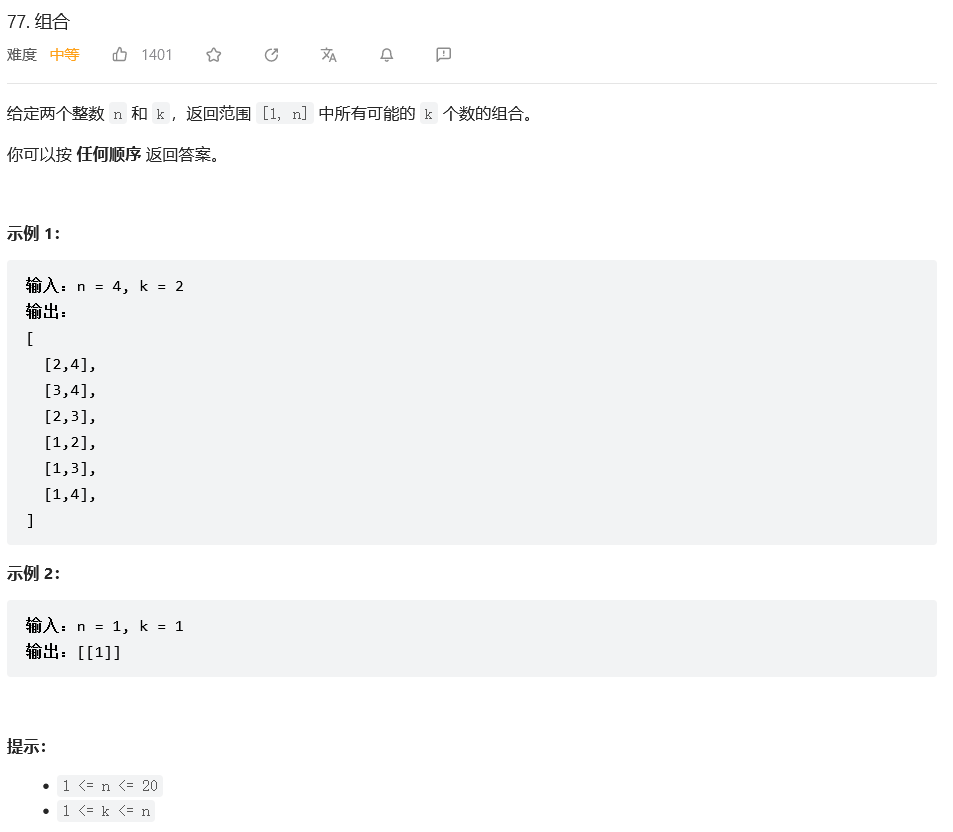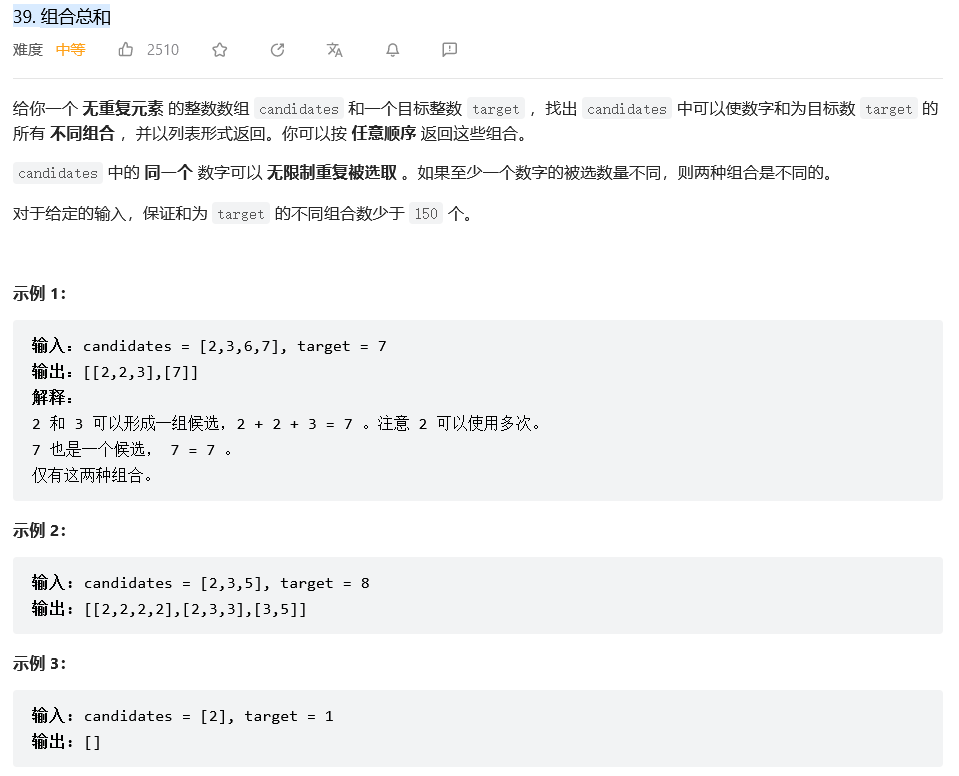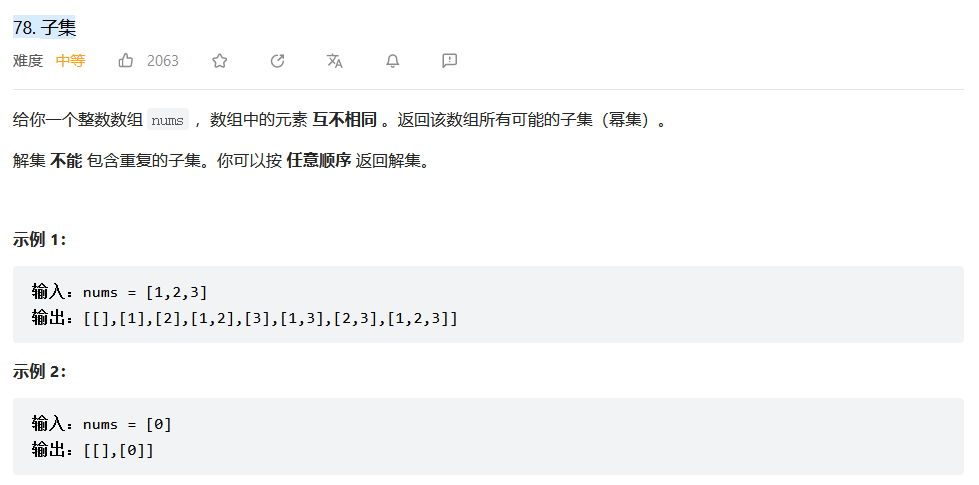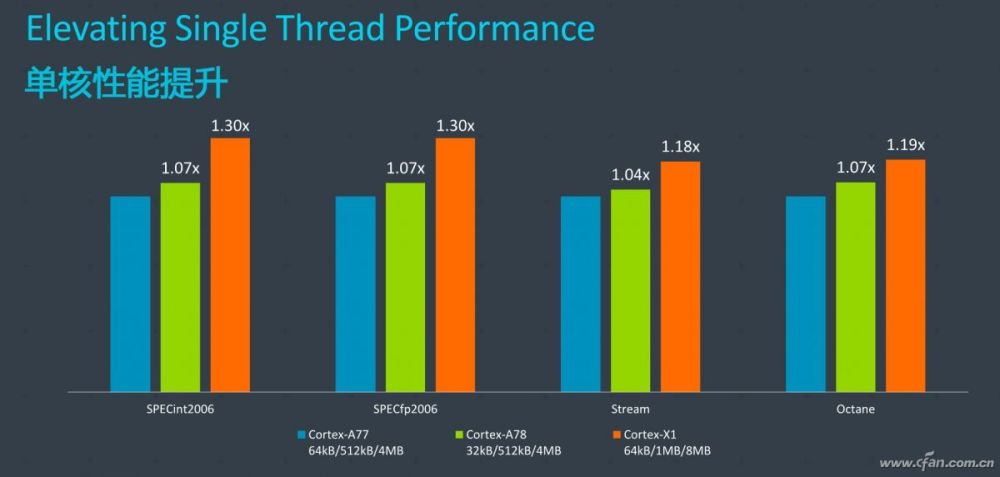文章目录
- 基本思想
- 回溯算法的递归框架
- 组合问题
- 组合总和
- 组合去重
- 子集
- 全排列
基本思想
回溯算法是一种递归算法,它试图通过尝试不同的选择,解决一个问题。它的基本思想是从可能的决策开始搜索,如果发现这条路往下走不能得到有效的解答,就返回上一层重新选择另外一种可能的决策,并且重复以上的步骤。
具体来说,回溯算法通过深度优先搜索的方式,遍历问题的解空间。在深度优先搜索的过程中,当搜索到某一层时,根据问题的限制条件判断该层的节点状态是否满足条件。如果条件不满足,则这个节点的状态被排除,并回溯到当前节点的父节点,重新进行遍历。如果条件满足,则继续搜索下一层的节点,并重复以上操作,直到搜索到一个符合条件的解或者遍历完整个解空间。
回溯算法一般适用于求解组合问题、排列问题、搜索问题等。由于在搜索过程中,需要不断地重新选择和放弃某个状态,所以回溯算法具有空间复杂度为 O(N) 的特点。
因为回溯算法的搜索路径呈现树形结构,所以有时候也被称作"回溯搜索"或"深度优先搜索+状态撤销"算法。
回溯算法的递归框架
回溯算法是一种典型的递归算法,它通常需要使用递归函数来实现。回溯算法的递归框架一般为以下形式:
def backtrack(candidate, state):if state == target: # 满足条件,输出结果output(candidate)return# 选择for choice in choices:make_choice(choice) # 做选择backtrack(candidate, state + 1) # 递归进入下一层状态undo_choice(choice) # 撤销选择
这个递归框架通常包括三个部分:选择、递归和撤销选择。具体来说,每次迭代中,算法选择一个可用的状态或者变量,进行尝试。然后进入下一层状态,继续进行递归。如果递归过程中发现当前状态不符合要求,则需要撤销前面的选择,回到上一层状态,重新开始搜索。
在回溯算法中,重点是如何定义选择和撤销操作。这些操作通常和具体问题相关,需要根据问题的特点进行定义。回溯算法的实现应该包括以下步骤:
- 判断是否到达了目标状态。当搜索到符合要求的状态时,将其输出,并结束搜索。
- 选择当前状态或变量。在当前状态的所有可选序列、可选子节点等中,选择一个未被搜索过的状态或变量。
- 尝试选择新状态。在进入下一层状态之前,需要先尝试选择新状态,完成相应的操作,比如加入选择列表等。
- 递归进入下一层状态。进入下一层状态并继续搜索。
- 撤销选择。如果当前状态不符合要求,需要撤销前面所做的所有选择、完成的操作等,返回上一层状态,继续搜索其他可选序列或子节点。
组合问题
LeetCode第77题:https://leetcode.cn/problems/combinations/
首先定义两个全局变量用于存放结果集和当前候选集合:
// 存放所有满足条件的结果
List<List<Integer>> ans = new ArrayList<List<Integer>>();
// 当前得到的候选集
List<Integer> temp = new ArrayList<Integer>();
- 递归的终止条件:找到了一个子集大小为k的组合,即
if (temp.size() == k) {ans.add(new ArrayList<Integer>(temp));return;
}
- 选择
for(int i = cur; i<=n;i++){temp.add(i); // 当前元素加入候选集合dfs(i+1,n,k); // 递归进入下一层状态temp.remove(temp.size() - 1); // 当前元素移除候选集合
}
完整代码
class Solution {List<List<Integer>> ans = new ArrayList<List<Integer>>();List<Integer> temp = new ArrayList<Integer>();public List<List<Integer>> combine(int n, int k) {dfs(1, n, k);return ans;}public void dfs(int cur, int n, int k) {// 剪枝:可选的元素不足K个if (temp.size() + (n - cur + 1) < k) {return;}if (temp.size() == k) {ans.add(new ArrayList<Integer>(temp));return;}for(int i = cur; i<=n;i++){temp.add(i);dfs(i+1,n,k);temp.remove(temp.size() - 1);}}
}
组合总和
LeetCode 第39题:组合总和:https://leetcode.cn/problems/combination-sum/
首先定义两个全局变量用于存放结果集和当前候选集合:
// 存放所有满足条件的结果
List<List<Integer>> ans = new ArrayList<List<Integer>>();
// 当前得到的候选集
List<Integer> temp = new ArrayList<Integer>();
- 递归的终止条件:当前候选集合总和大于target或找到总和为target的组合,即
if(sum > target){return;
}
if(sum == target){res.add(new ArrayList<Integer>(temp));return;
}
- 选择
for(int i=index;i<candidates.length;i++){temp.add(candidates[i]); // 当前元素加入候选集合sum+=candidates[i]; // 当前候选集总和dfs(candidates, target, i); // 递归进入下一层状态// 当前元素移除候选集合sum -= temp.get(temp.size()-1);temp.remove(temp.size()-1);
}
完整代码
class Solution {List<List<Integer>> res = new ArrayList<List<Integer>>();List<Integer> temp = new ArrayList<Integer>();int sum = 0;public List<List<Integer>> combinationSum(int[] candidates, int target) {dfs(candidates, target, 0);return res;}public void dfs(int[] candidates, int target, int index){if(sum > target){return;}if(sum == target){res.add(new ArrayList<Integer>(temp));return;}for(int i=index;i<candidates.length;i++){temp.add(candidates[i]);sum+=candidates[i];dfs(candidates, target, i);sum -= temp.get(temp.size()-1);temp.remove(temp.size()-1);}}
}
组合去重
LeetCode第40题: 组合总和 II:https://leetcode.cn/problems/combination-sum-ii/
在上一题组合求和基础上,定义一个used数组记录元素是否是否过:
- 递归的终止条件:当前候选集合总和大于target或找到总和为target的组合,即
if(sum > target){return;
}
if(sum == target){res.add(new ArrayList<Integer>(temp));return;
}
- 选择
for(int i=cur;i<candidates.length;i++){//当前元素是否有效if(i>0&&candidates[i]==candidates[i-1]&&used[i-1]==false){continue;}temp.add(candidates[i]); // 当前元素加入候选集合used[i] = true; // 标记当前元素已使用sum += candidates[i]; // 当前候选集总和dfs(candidates,target,i+1,sum,used); // 递归进入下一层状态// 当前元素移除候选集合sum -= temp.get(temp.size() - 1);temp.remove(temp.size() - 1);used[i] = false;
}
for(int i=index;i<candidates.length;i++){temp.add(candidates[i]); // 当前元素加入候选集合sum+=candidates[i]; // 当前候选集总和dfs(candidates, target, i); // 递归进入下一层状态// 当前元素移除候选集合sum -= temp.get(temp.size()-1);temp.remove(temp.size()-1);
}
完整代码
class Solution {List<List<Integer>> res = new ArrayList<List<Integer>>();List<Integer> temp = new ArrayList<Integer>();public List<List<Integer>> combinationSum2(int[] candidates, int target) {Arrays.sort(candidates);boolean[] used = new boolean[candidates.length];dfs(candidates, target, 0, 0, used);return res;}public void dfs(int[] candidates, int target, int cur, int sum, boolean[] used){if(sum > target){return;}if(sum == target){res.add(new ArrayList<Integer>(temp));return;}for(int i=cur;i<candidates.length;i++){if(i>0&&candidates[i]==candidates[i-1]&&used[i-1]==false){continue;}temp.add(candidates[i]);used[i] = true;sum += candidates[i];dfs(candidates,target,i+1,sum,used);sum -= temp.get(temp.size() - 1);temp.remove(temp.size() - 1);used[i] = false;}}
}
子集
- 子集: https://leetcode.cn/problems/subsets/
class Solution {List<List<Integer>> res = new ArrayList<List<Integer>>();Deque<Integer> temp = new ArrayDeque<Integer>();public List<List<Integer>> subsets(int[] nums) {dfs(nums, 0);return res;}public void dfs(int[] nums, int index){res.add(new ArrayList<Integer>(temp));for(int i=index;i<nums.length;i++){temp.addLast(nums[i]);dfs(nums, i+1);temp.removeLast();}}
}
全排列
- 全排列: https://leetcode.cn/problems/permutations/
class Solution {List<List<Integer>> res = new ArrayList<List<Integer>>();List<Integer> temp = new ArrayList<Integer>();public List<List<Integer>> permute(int[] nums) {boolean[] used = new boolean[nums.length];dfs(nums, used, 0);return res;}public void dfs(int[] nums, boolean[] used, int index){if(temp.size() == nums.length){res.add(new ArrayList<Integer>(temp));return;}for(int i=0;i<nums.length;i++){if(used[i]){continue;}used[i] = true;temp.add(nums[i]);dfs(nums, used, i+1);used[i] = false;temp.remove(temp.size()-1);}}
}








